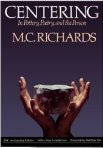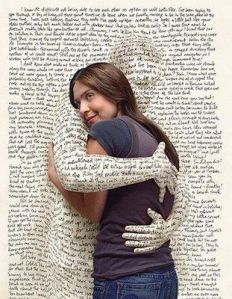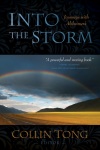We people like to make things. We are creators. We build things. We make art.
To make art, we need materials, media. We shape sculptures from metal, wood, ceramics, and other materials. We create pictures with paint on canvas or paper. We create photographs with light, paper, and emulsion—or with digital technology. And we make worlds with words.
While I have written in various forms for most of my life, I’ve also experimented with other forms of art. I’ve made a few sculptures from salvaged metal, I’ve created multi-media shadow boxes for charity art auctions,  and I’ve spent years learning to throw and fire ceramic pots. There is something therapeutic, even spiritual, about the creative process, whatever media one chooses. (See M. C. Richards’ Centering in Pottery, Poetry, and the Person for an excellent example of the intersection of spirituality and art.)
and I’ve spent years learning to throw and fire ceramic pots. There is something therapeutic, even spiritual, about the creative process, whatever media one chooses. (See M. C. Richards’ Centering in Pottery, Poetry, and the Person for an excellent example of the intersection of spirituality and art.)
I’ve found that to be especially true of pottery and of writing—both poetry and prose. And I find myself particularly fascinated by the process of writing, by the creation of worlds from words. Language seems to me to be very different from other kinds of artistic media—with perhaps the exception of music, which is itself a kind of language. Metal and wood and paint and clay all have substance or mass. They are materials shaped by the artist’s hands and tools into physical objects that can be seen, touched, held.
Writers too shape their media. We put words together into sentences or fragments, paragraphs or stanzas. And our work can be seen, touched, and held as books. But the art we create isn’t really the physical artifact of the book that holds our words. Certainly, we (with the help of our publishers, cover artists, and printers) create that artifact. But the real art of the writer is the creation of a world. Our words bring places, characters, relationships, and actions to life in the minds of our readers. We take stories and people that are born in our own minds, and through the act of writing, of stringing words together on a page, we share those stories and people with others.
When I stop and think about it, this seems miraculous to me. How is it that bits of (actual or digital) ink on a page transform into characters that seem to live and breathe and love and hurt and bleed and die?
 All of us who love to read know that the characters in our favorite books feel to us like friends or family. Often, we return to a book over and over because we want to live in its world again and again. I, for example, have thought for a while now that it may be time to re-read the Harry Potter series (see Jennifer Flaten’s recent post on Harry Potter here). We can get so caught up in the worlds we read about that they haunt our dreams or follow us through our waking lives, because we just can’t get them out of our heads.
All of us who love to read know that the characters in our favorite books feel to us like friends or family. Often, we return to a book over and over because we want to live in its world again and again. I, for example, have thought for a while now that it may be time to re-read the Harry Potter series (see Jennifer Flaten’s recent post on Harry Potter here). We can get so caught up in the worlds we read about that they haunt our dreams or follow us through our waking lives, because we just can’t get them out of our heads.
I remember when I was a college student, home for a few days vacation, staying up late into the night reading Peter Straub’s Ghost Story and having the sense that I couldn’t stop reading, couldn’t put  the book down unfinished, or the ghosts would escape from the book and destroy me in my sleep. I did put the book down unfinished, and I did fall asleep, and the ghosts didn’t get me. But that whole incident illustrates something to me about the creative energy of books and writing. Our words live on the page between the covers of the book, but our worlds live outside those covers, in our own minds, in our readers’ minds, in the interaction between the words on the page and the reader who reads them. It is as if, on some level, the books we create are themselves the media for our real art, which is the alchemical transformation of words into worlds enabled by the act of reading.
the book down unfinished, or the ghosts would escape from the book and destroy me in my sleep. I did put the book down unfinished, and I did fall asleep, and the ghosts didn’t get me. But that whole incident illustrates something to me about the creative energy of books and writing. Our words live on the page between the covers of the book, but our worlds live outside those covers, in our own minds, in our readers’ minds, in the interaction between the words on the page and the reader who reads them. It is as if, on some level, the books we create are themselves the media for our real art, which is the alchemical transformation of words into worlds enabled by the act of reading.
 In Jasper Fforde’s wonderfully inventive (and funny) Thursday Next series, characters can move between the “real” world (a sort of parallel world to ours) and the literary worlds of novels. In the first book in the series, The Eyre Affair, Jane Eyre is kidnapped from the novel, and Thursday Next, a literary detective, is charged with solving the crime. Thursday ends up in the novel for a bit, and ultimately affects the story in a small way.
In Jasper Fforde’s wonderfully inventive (and funny) Thursday Next series, characters can move between the “real” world (a sort of parallel world to ours) and the literary worlds of novels. In the first book in the series, The Eyre Affair, Jane Eyre is kidnapped from the novel, and Thursday Next, a literary detective, is charged with solving the crime. Thursday ends up in the novel for a bit, and ultimately affects the story in a small way.
Fforde’s novels play on that ability of writing to create worlds that feel real enough that we could inhabit them—or characters that feel real enough that they could inhabit our world.
From words to worlds.
It’s a kind of magic, really.
Book embrace image from pembrokepubliclibraryblog.blogspot.com.
Book covers from Amazon.
Connect with Stephanie Stamm:
http://www.stephanieastamm.com
Stephanie Stamm is the author of the New Adult/Young Adult urban fantasy A Gift of Wings. (The sequel, A Gift of Shadows, will be released late 2014.)
She has also contributed stories (one fictional and one true) to the following volumes:




Interesting post, Stephanie. I believe that all (or most) writers have other creative endeavors. I know I have several, including music, sewing and needlework, and quilting. All those forms of art give me pleasure and I find stories in each thing I create. I like your reference to writing and the real world. I’ve read books I couldn’t put down and books I couldn’t wait to put down. A good writer captures the attention of his reader and pulls the reader into the story. The reader knows the difference between the real world and the book, however, for a brief time the real world takes a back seat as the reader is drawn into a world of the writer’s imagination and explores that world through the writer’s words. Enjoyed this!
LikeLike
Thanks, Linda! I find myself obsessing about this sometimes. I’m just amazed at how embodied characters created from words can feel. And, yes, many creative outlets. I remember you sharing your music with us. 🙂 That need to create is huge.
LikeLike
Words to worlds, what a wonderful way to put it. I think we all ‘dabble’ in the varying arts forms. I know I have, especially music, but I’ve tried my hand at painting-not the best use of my creativity. Still you make a good argument for writing. I do revisit the stories that move me on a deeper level than just a quick read.
A post worth re-reading. Doris
LikeLike
Thanks, Doris! Yeah, you seem to have many different art forms–acting, writing and music.That’s great! I’m not so good at painting myself–two-dimensional art is not my strong suit. Someday maybe I’ll try to learn more about that.
LikeLike
Beautifully written post, Stephanie. I wish I had the time to revisit some of the novels I’ve read in the past but there have been many novels that I know I enjoyed and have forgotten the titles of, and the authors who wrote them. The great thing about individual words, though, is that I don’t forget them. I love the difficult ones and the more meaningful ones for me have often been learned from some of those titles that I’ve forgotten. Those words, and the meanings of, have ‘stuck’ and I really enjoy using them when I can.
LikeLike
Nancy, what a great spin–to turn back to the words themselves. Very cool! I’ve certainly learned a lot of vocabulary by reading. Sometimes it takes me a long time to realize how a word is really pronounced, since I’ve only seen it in writing. 🙂 I love finding out the etymologies of words too.
LikeLike
This gives us an interesting insight into the crreative process.
Sent from my iPad
>
LikeLike
Well said, or I should say, well written. I like the phrase: we make worlds with words. In the ’70s when I was in my 20s, I recall a professor telling us that words — both written and spoken — are the symbols we have for our ideas and concepts so that we can share them with others. Otherwise, they’d just stay in our heads.
LikeLike
Thanks, Mike! That’s a good explanation/illustration from your professor. That’s part of what fascinates me, I think. Words are representations of something that then take on a life of their own–sort of. Amazing!
LikeLike
Thanks, Abbie! It’s maybe my own little obsessive quirk. But sometimes I just can’t stop ruminating on the power of story and that move from the author’s mind to words on a page to to the reader’s mind–and what is made real in that transaction.
LikeLike
Interesting Stephanie. Since I came to writing novels much later than most people, i am very aware that every word is a form of art. I do other types of art and I plan to share some of that at a couple of my book signing. I had a friend who when she was reading the Exorcist, her room turned ice cold and she threw the book across the room never to be read again. LOL Cher’ley
LikeLike
Aahhh! Yeah, I wouldn’t read it anymore either, Cher’ley! That’s a nice way to look at it–that every single word is a work of art. It’s cool that you are sharing your other art at your book signings.
LikeLike
I remember reading all day in the Orly airport (some sort of plane mix up) and when our flight was finally called, I was so lost in the story I wasn’t sure where I was. That sort of thing has happened more than once. Words have always transported me more than images (movies, tv). Perhaps because I build the worlds based on my interpretation of the words, not someone else’s vision.
Music was my other traditional art form (piano and voice), but working with my horses in another form of art, particularly when we become one – no words needed there.
LikeLike
What a great example of how words can absorb and transport us. And I can definitely see how your work with your horses is an art form–“when we become one”–just beautiful!
LikeLike
So enjoyed your post, Stephanie! I, too, was taken with your phrase ‘making a world with words” because that is exactly what we writers do (or at least try to do!). Hopefully, we intrigue readers so that they keep turning the pages and envelope them into our stories!
LikeLike
Thank you, Gayle! I liked the phrase–and also like the fact that there’s only one letter of difference between the two words. 🙂 I love getting pulled into a new story. And now I’m seeing that book/hug illustration a little differently–like the embrace could actually pull the girl right into the book. There may be a story there. 🙂
LikeLike
I think all writers are creative people. Some are solitary while others are outgoing. Many of us explore other creative venues but return time and time again to writing as our creative form of expression. Placing the reader in the world we have created I think is the ultimate goal of any writer.
LikeLike
I’d agree that that’s our ultimate goal, SJ–whatever kind of world we are creating. And I think we return to writing, because, ultimately, we create those worlds for ourselves first of all.
LikeLike
Great post. For me, if I can’t connect to the characters, I don’t connect to the books/series which is why I’m waiting for your next installment. 🙂
LikeLike
Aw, thanks, Erin! I’ve committed to a release date of Dec. 10 for Shadows (eek!), so it’s coming soon. I’m going to have to do a quick, quick cover reveal next week. Not much time to spread the word. I may just post the reveal myself–and then see if I can get some other bloggers involved in the actual release. I’m waiting for your next one too! 🙂
LikeLike